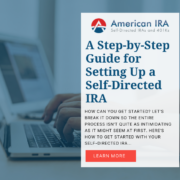Avoid Tax Traps for After-Tax Self-Directed IRA Funds
 Generally, distributions and Roth Conversion amounts from your Traditional Self-Directed IRA are treated as taxable income to you. However, if you have after-tax amounts in your Traditional Self-Directed IRA, distributions and Roth conversion of these after-tax amounts should be tax-free. You could mistakenly pay income tax on these amounts if the proper tax filing and reporting is not done.
Generally, distributions and Roth Conversion amounts from your Traditional Self-Directed IRA are treated as taxable income to you. However, if you have after-tax amounts in your Traditional Self-Directed IRA, distributions and Roth conversion of these after-tax amounts should be tax-free. You could mistakenly pay income tax on these amounts if the proper tax filing and reporting is not done.
Where Do After-Tax Funds Come From?
Your Traditional Self-Directed IRA will include after-tax funds if you made contributions and did not claim a tax deduction for all or a portion of the amount on your tax return. The deduction may not have been claimed because you and/or your tax advisor simply chose not to, or because you were ineligible to claim the deduction because you received benefits under an employer plan and your income exceeded a certain amount.
Your after-tax funds may also be attributed to a rollover of after-tax amounts from an account under an employer plan, such as a 401(k) or 403(b) plan, to your Traditional IRA.
Ensuring After-Tax Funds are Not Taxed
The IRS provides Form 8606 in order to track and report after-tax funds in your Traditional Self-Directed IRA. To this end, Form 8606 must be filed for any year that you make nondeductible contributions to your Traditional IRA. Additionally, Form 8606 must be filed for any year that you take a distribution or convert funds to a Roth IRA if your Traditional IRA has after-tax funds the year that the distribution or Roth conversion is done. By accurately completing and filing Form 8606, you keep track of the after-tax balance and share the information with the IRS.
Balance Aggregated and Pro-Rated for Taxation
Distributions or Roth conversion amounts from your Traditional Self-Directed IRA will include a pro-rated amount of after-tax and pre-tax funds as long as your Traditional IRA includes an after-tax balance. As such, you cannot select only after-tax or pre-tax funds when performing such transactions. Furthermore, all of your Traditional IRAs, SEP IRAs, and SIMPLE IRAs are treated as one when determining how much of a distribution or Roth conversion amount is not taxable.
For instance, assume that you have two Traditional Self-Directed IRAs: Traditional IRA #1 has a balance of $10,000 all of which is after-tax funds. Traditional IRA #2 has a balance of $90,000 all of which is pre-tax funds. If you take a distribution (or Roth Conversion) of $10,000 from Traditional IRA #1, only $1,000 will be tax-free and $9,000 will be taxable. This rule applies because, for IRS purposes, you took a distribution of $10,000 from an aggregate Traditional IRA balance of $100,000.
Caution: Determine Balance Formula
When determining the ratio of the taxable vs. nontaxable portion of a distribution or Roth conversion, the balance as of the end of the year in which the transaction is done is used. If the transaction is done in January when you had only Traditional Self-Directed IRA #1 with a balance of $10,000, and you rollover a pre-tax amount of $90,000 from your 401(k) to Traditional Self-Directed IRA #2 in December of the same year, your account balance used in the formula would be $100,000 (plus or minus interest or losses) .
The year-end balance is also adjusted by adding the following amounts:
- Distributions taken from your Traditional Self-Directed IRA during the year and rolled over the next year within 60-days of receipt. For instance, if you took the distribution in December and did a rollover of the amount in January.
- Roth IRA conversions done during the year and re-characterized the following year. Under Roth conversion rules, you can reverse a Roth conversion by doing a re-characterization of all or a portion of the amount by your tax filing deadline plus extensions.
Other distributions and Roth IRA conversions done during the year may also need to be included in the calculation.
Image by: presentermedia.com




